“All failure is failure to adapt, all success is successful adaptation.”—Max McKeown
We all know, hopefully, that learning is an ongoing process that is never complete. After 20 years of kettlebell training, we continue to learn, and our most recent lesson might just help a lot of you with your military press goals.
What led to an epiphany on the grip for the kettlebell military press after 20 years?
A little pain was all it took, a little unsuccessful adaptation that made us reevaluate the recommended grip.
I (Brett) had the chance to review and edit Fabio’s excellent military press video, VICTORIOUS, and I immediately embraced the grip recommendation he made in that video. And fast forward several weeks and I had developed some “grumpy” acromioclavicular joints (AC joints) on both shoulders. By grumpy I do mean painful. I started trying to figure it out but looked everywhere but my grip. It was only after exhausting the search that I came back to the head slapping moment of realizing the only thing I had really changed was my grip.
That led me to actually look at my hand. Cue joke: “I know that like the back of my hand…oh…I never noticed that before!”
But that is exactly what happened. I looked at the structure of my hand and wrist for the “first time.”
What did I see? A very different hand and wrist structure from Fabio’s. Then I started looking at anatomical information and drawings and noticing variations in those as well.
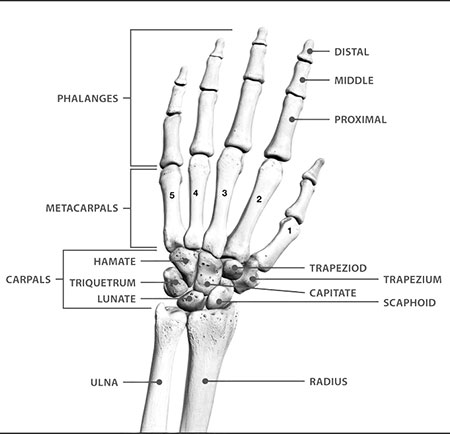
The anatomy and function of the hand and wrist are truly a marvel. The integration of 27 bones, 27 joints, 34 muscles, over 100 ligaments and tendons and many nerves, blood vessels etc…. If you include the radius and ulna, you have 29 bones and even more joints. The area can bear weight, deliver blows, perform brachiation, and manipulate objects with a fine motor skill necessary to create magnificent works of art. A marvel indeed.
But that structure has variation in it and that structure influences our function. The converse is also true that our function influences our structure. A two-way street and Zen puzzle.
So, how does hand/wrist architecture influence your grip for the kettlebell military press and how to find your optimal grip?
So glad you asked. ;-]
Why Does It Matter?
Let’s begin by looking at structure and function in the kettlebell military press.
Alignment matters in the application of strength and power. How force moves through the body to produce the desired outcome can determine success and efficiency or can result in injury at worst or inefficiency at best. The structure (bones), soft tissue (muscle, tendon, etc…), and neurological system (nerves and patterning) all work together to produce all movement.
Specific to the kettlebell military press we will first assume that the lower body position is correct and midsection stability is solid. If either of these is not dialed in, you would need to address that first.
Next, the uniqueness of the offset center of mass (COM) of the kettlebell and keeping it aligned over the elbow should be understood. Up to a certain point that offset COM guides the shoulder into a better lockout but past a certain load it challenges the alignment of the structure as the COM of the kettlebell is maintained over the elbow and down through the shoulder at lockout. What is the “kick over” point in load where we go from assisting to challenging? That depends on the individual and their structure and strength. For myself the 40kg is where the COM becomes a challenge, but you will find your own “kick over” point in load.
Humeral length and forearm length come into play as well. In order to determine whether you have a short or long humeral length, place your arm in the overhead pressing position. If the bend of the elbow is below or even with the top of the head you have a short humerus and if the bend of the elbow is above the top of the head you have a long humerus. The difference in humeral length will result in different pressing paths just like short and long femurs will influence squatting. A short humerus will likely have a straighter pressing groove with less “lean away” from the kettlebell; where a long humerus will have more angle and, because the weight is further from midline, will result in more “lean away.” Forearm length will change how the COM of the kettlebell is maintained with a short forearm stacking the COM in an easier fashion and the long forearm creating a longer lever arm.
The mechanics of the scapula must also be appropriate with proper lateral rotation and scapulothoracic rhythm without elevation so the force coupling mechanism of the glenoid and humeral head can be maintained.
The structure of your hand and wrist influences all these areas since it is how we are interacting with the kettlebell and controlling the center of mass. We want the weight of the kettlebell and handle to center the force into center line of the hand and wrist ensuring equal “contribution” between the radial and ulnar neural components.
Three Different Structures
Let’s establish the three dominant types of hand/wrist structure.
- Ulnar deviation—the dominant position is “tilted” in the direction of the ulna
- Radial deviation—the dominant position is “tilted” in the direction of the radius
- Neutral—no tilt and “centered” position
One thing to add to the conversation is the alignment and position of the thumb but more on that in a bit.
I am an example of ulnar deviation:
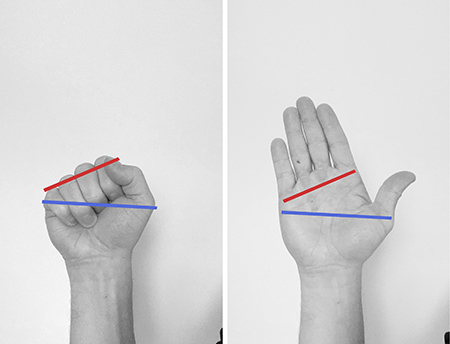
Fabio is an example of radial deviation:

Dr. Kathy Dooley is an example of neutral:
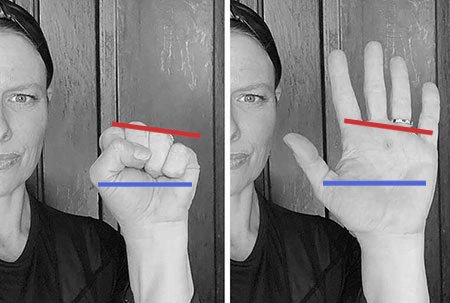
Each of us will have a different grip for the military press based on our hand/wrist structure.
- Ulnar = angled, depth dictated by thumb, “thumb side” grip
- Radial = deep, parallel, “pinkie side” grip
- Neutral = parallel to callouses, center grip
When we do not match the grip to the hand/wrist structure the force will not align with the structure and the COM of the kettlebell will produce torque at various areas involved in the military press. However, if we use the grip that best works with our structure, the force we apply in the press moves through the system efficiently while the COM of the kettlebell is well controlled and aligned.
Finding Your Structure
How do you find which structure you have?
- Stand in front of a mirror or film yourself bringing your hands up into a “surrender” position so the shoulders and arms are in a natural position.
- Once there, open and close the hands three to five times.
- Look at the position of the hand/wrist with the fingers open and with the fingers in a light fist.
- You should recognize one of the three structures.
For further confirmation perform the thumb to pinky pinch.
Bring the tip of the thumb to the tip of the pinkie finger. (Ideally, this happens in the middle of the palm/hand.)
If you have a training partner or friend available have them grab the sides of the nail bed of each (thumb and pinky) and try to pull your thumb and pinkie apart in these positions:
- Ulnar deviation
- Radial deviation
- Neutral
Any combination of the three above with some wrist flexion.
Any combination of the three above with some wrist extension.
If you found that your structure is radial deviation, then you are likely stronger in radial deviation and weaker in ulnar deviation or neutral. Ulnar is stronger in ulnar deviation and neutral in neutral.
If you do not have a training partner or friend, try to pull the index finger of the opposite hand through the thumb to pinky pinch. You should still find one position stronger and the others weaker.
The Thumb
One additional aspect of the architecture to look at is the thumb position.
Note on this picture of my hand how high my thumb joint sits in the palm vs. where Fabio’s thumb joint sits.
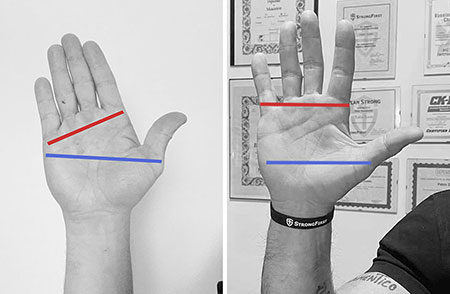
The position of my thumb high in the hand will also influence where the handle sits in my hand (higher with an angle) just as it will for Fabio (lower and parallel).
Practicing with the best grip for your structure can be put into practice with the get-up.
Then working on bringing the optimized grip into your press can be performed first in a cheat clean where the additional control of the cheat clean assists you in finding the optimized grip for each rep.
After some time on the cheat clean begin to “peel” away the assistance and return to the clean without assistance as you are still able to land in the optimized grip.
Final Thoughts
In conclusion: “A wise man adapts himself to circumstances, as water shapes itself to the vessel that contains it.”—Chinese Proverb
Structure and function are a two-way street. Function can influence structure—like my AC joints getting irritated by the wrong grip for my military press. And structure can “dictate” function—like finding your hand/wrist structure and using the optimal grip “dictated” by it.
Give this a try and let us know your results on the StrongFirst Forum.
A huge thank you to Dr. Kathy Dooley for her knowledge and input on this article.
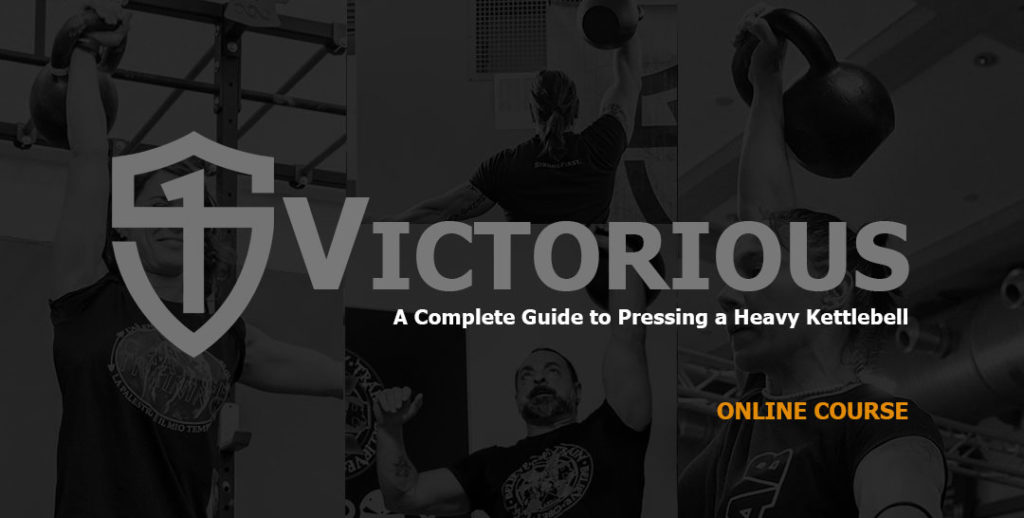
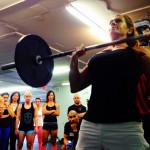
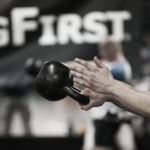






What a great article!
I have been training KB for more than 6 years with the thumb side grip.
I have always had pain on my thumbs and elbows whenever I did TGU and KB press. So I never went heavier than 32kg.
Today I tried the pinkie side grip. To my surprise, I was able to press and TGU with 40kg without any pain!
Thank you so much for sharing your awesome works. You truly are a coach of great insight
Excellent Saehyun Choi—please keep us posted on your progress on the StrongFirst Forum.
Great Article Brett.
I would have never thought about this. I was always taught to press through the pinkie side of the hand (typically driving through the pisiform). Fortunately I am more neutral to radially deviated.
Will be education our students on appropriate grip moving forward!
Warmly,
Bijan
Excellent and thank you Bijan
Awesome article as always, Sir!
I’m hardly catch the difference between radial and neutral hand, especially the “top mark” in my own hand. I’m understand that there is a slight angle in the neutral in contrast to the radial, but I couldn’t really decide.
Can you help me what should I see as a reference point (I used a “pen” as marker and put it on my fist and on my palm as well…is this a good way to check it?) to notice that (lack of that?) slight angle?
Thank you, for your help!
árpád—you are looking at the overall “angle” (or lack of) of the wrist etc. There is a thread on the forum where you could post a picture and we can take a look there. It does sound like you are more neutral.
Thank you, Sir!
A really timely article for me; really enlightening, thank you.
I can’t stop looking at my hands now 🙂
Thank you Peter…it does make you take notice ;-]
What a brilliant article! I was looking forward to it ever since you mentioned it on of your podcast interviews and was not disappointed.
One question regarding the cues on VICTORIOUS!
Fabio advises to use ulnar deviation at the top. However, given that he exemplifies radial deviation: Does this cue still apply to people who exemplify ulnar deviation in general? Or should they just continue their alignment or even go for radial deviation at the top?
I hope my questions are clear and they make sense to you (or Fabio) 🙂
Thanks for all your great work.
Bauer—as I noted on the forum…the ulnar deviation advice may still help with lockout but it is the intention of the ulnar deviation not movement of the wrist/bell. If you are pressing heavy enough you won’t be able to actually change the wrist but the intention may help with lockout. IMO
Very interesting article. Thank you for sharing this info. how does training impact the structure deviation? I never took note of the ‘back of my hand’ until today but had 2 conflicting activities in the life of my hands:
1. Karate as a kid (Kobra Kai style…not the nice kind, when you say “Ooos sensei Tiger”, it may be better to take up running at that moment).
Our punching fist was focused on the 1st 2 knuckles, and our kunckle pushups were the same. these knuckles are still larger than the others.
2. Shaolin Kung Fu (good school) started ~20 years after stopping Karate.
Our punching fist was focused on the last 2 knuckles (small finger and neighbour). and the Kpushups were the same.
today, i see that I have a neutral hand and naturally hold the KB against all 4 callouses.
xcal—Go with the neutral wrist advice for the MP and see how things go. I’ve seen some of those knuckles and hands that have adapted to punching like that.
Great article Brett. Thank you, now I understand a lot better why I struggled to feel stronger with the “carry the torch” wrist position variation of pressing.
Do you think those three devotions carry over, or affect grip for heavy swinging too? I’d guess the wrist and grip sets up more naturally with dynamic ballistic moves and we don’t overgip the bell when swinging. But perhaps it’s with investigating.
Marcin—I think this grip advice is pretty specific to the “loaded” wrist of the KB press. The wrist and grip for the swing for example is specific to that and yes we are looking at the differences.
This is a great article and it helped me finally understand why the traditional ‘deep’ thumb-side insertion of the Girevoy style has always felt weaker to me than the pinkie-side insertion. Amazing depth of analysis going a mile deep, by a true master. Shared this with all my students and they’ll all be figuring out their hand structure for better pressing. Thank you, Brett.
Thank you Kat
Many thanks for the article. Confirms my trial and errors, over the years. I’m neutral but have been encouraged on occasion to be more radial ( presumably the guys and gals encouraging we’re not neutral)
I do have a question on training regime though if anyone can advise?
I have been a S&S guy for long time now . Using it just to keep me nimble and strong for life ( work and the kids)
I decide early this year to change job and life style a little going self employed and opening up an holistic health and wellness practice for the over 40/50’s.
Part of this new move is to gain my SFC1, so I was following the online plan aiming to test this October.
Sadly, other duties mean I have to postpone this test date until early next year. I moved my regime to the C&J A+A programme and so far I’m loving it. But, the snatch test kept tugging at back of my mind so I changed the 2nd day of the A+A to snatch instead of the C&J protocol outlined.
Am I wrong to do this? My aim is to keep strength and power ticking over until I know when I am testing again and the return to the testing preparation programme.
Any thoughts / ideas greatly appreciated.
Thanks for all the information, advice and support. It really is much valued.
Mike—thank you and I think the second day of A&A snatches makes sense for now to keep practicing that skill and progress towards a more snatch test specific program as time goes by.
Thank you very much for this article!
It took me several years to find the right grip for the TGU, and a lot of trial and error.
Finally, the strategy I use is very personal, so reading this article is quite liberating.
I will also add that the optimal grip depends on the kettlebell model (at least for me)… For example, on heavy kettlebells, the handle has not the same size on the old RKC models and on the new StrongFirst models, and this leads me to not use the same grip for two different bells of the same weight.
Thank you again !
Matthieu
Matthieu—Thank you and agreed that the KB design can impact the proper grip as well.